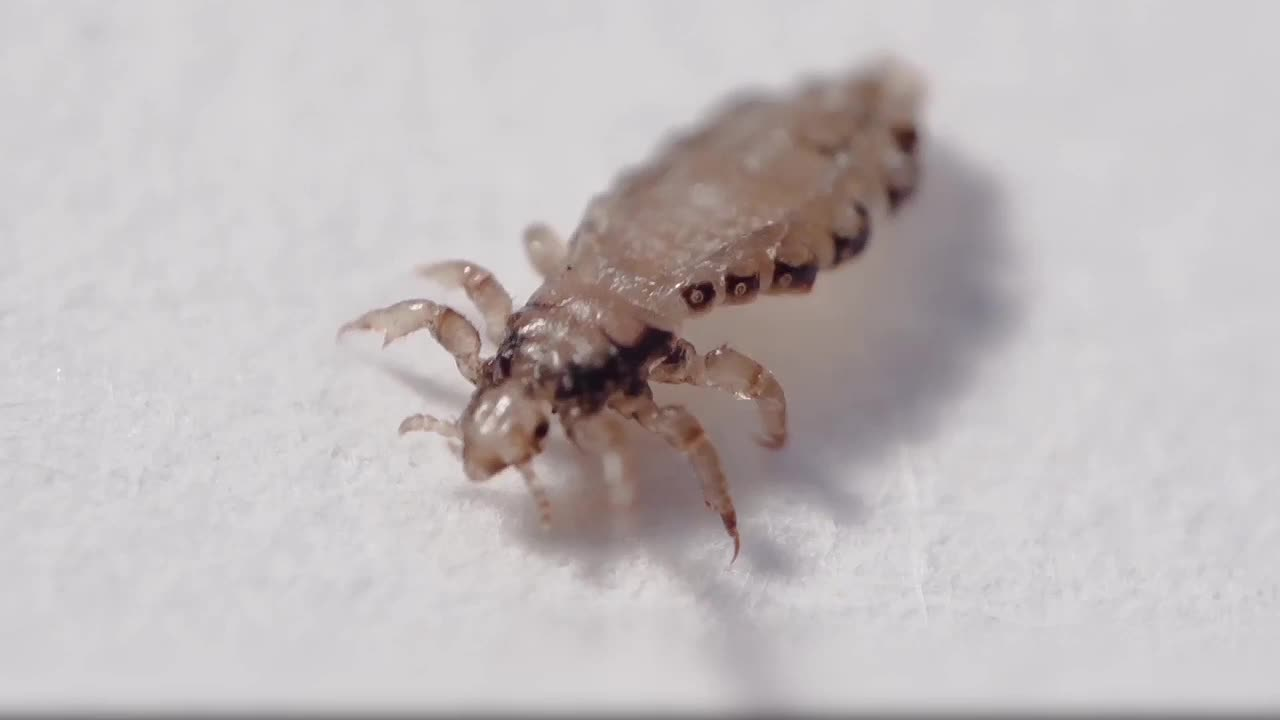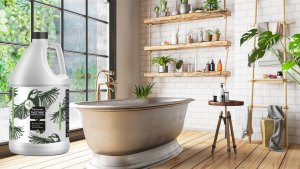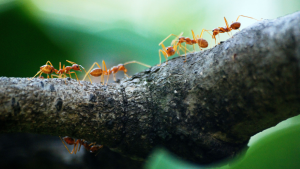Lice are some of the oldest pests humans have dealt with – medical historians have traced head lice infestations back to over 9,000 years ago – and they are still prevalent throughout the world today. Although lice are able to transmit several diseases (Typhus, trench fever, impetigo, and relapsing fever) in the United States they are simply deemed more “repugnant” than an actual health concern; for example, in 2018 Michigan schools took the decision to no longer require reporting or sending children home who have lice!
While lice infestations can cause itchiness, be nasty/gross, and be contagious to others; it is important to note that the poisons & chemicals used to control them have far more dangerous consequences than the lice. Direct effects from using chemical lice treatments contain, but are not limited to: dizziness, allergies, respiratory problems, burning, leukemia, cancer, brain tumors, attention deficit disorders, and even death in extreme cases.
This article will explain in-depth lice control using safe, natural alternatives that are much more effective than any chemical, poison or pediculicide.
Table of Contents:
Lice Biology
Resistance to Chemicals
Pestisafe® Control
Final Thoughts
Lice Biology
For the purposes of this article we will focus on lice that occurs on humans. There are three main categories of human lice: head lice, body lice, and crab lice. Head & body lice are very similar to one another, as they are both subspecies to Pediculus humanus. They are wingless, have six legs, claws for gripping to hair shafts, and their abdomens are longer than they are wide; their colors range from dirty-white to rust to gray-black. Head lice are almost always found living on heads, with their nits (eggs) glued to hair shafts.
Body lice can be found living in the seams of unwashed clothing, blankets, and sheets where they will crawl to their host to feed. Their nits can be placed in clothing or blankets/sheets or also attached to body hair. NOTE: lice can change color to match their hosts hair color.
Crab lice only live on hairy portions of the body as they have special adaptations for grasping hairs that a spaced widely apart. Usually they are found in the pubic & perianal regions, however, they can be found living in other areas, such as: eyelashes, armpits, and on the head.
A louse has been magnified, alongside a hair shaft, below for better viewing.
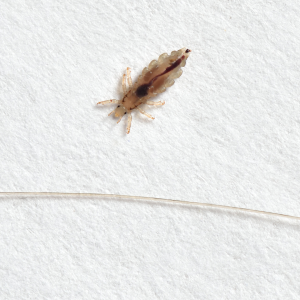
Female lice can produce between 50-150 nits (6-10 nits per day) and try to hide their nits behind ears and on the nape of the neck. It takes 5-10 days for the nits to hatch into the nymphal stage, from there it will be another 8-22 days for them to mature into adults and will live for about another three weeks. At this stage they are around 1/8 in. long, for reference that is about the size of a sesame seed.
The three lice species above can only feed on humans, meaning they cannot take on other hosts, such as: dogs, cats, or other animals. Normally lice cannot survive longer than two days without a blood meal.
Resistance to Chemicals
The conventional response to lice infestations is to resort to chemical treatments with active ingredients being: malathion, permethrin, lindane, pyrethrin, and ivermectin. Not only are all these options hazardous to human health, they are also highly ineffective due to high resistance among lice populations.
Let’s use the following illustration to walk through how the resistance to chemicals works.
We have a colony of 18 lice and decide to use a combination of two chemical shampoos for treatment, malathion & pyrethrin. The majority of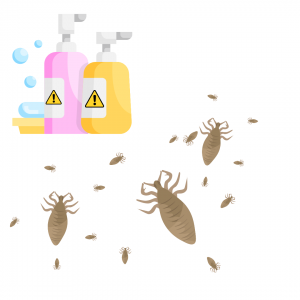 the colony (15 for our example) are wiped out by the poisons and only three larger lice remain. These three have survived and begin to mate and spawn an entirely new generation with their advanced traits – including the genes for chemical resistance.
the colony (15 for our example) are wiped out by the poisons and only three larger lice remain. These three have survived and begin to mate and spawn an entirely new generation with their advanced traits – including the genes for chemical resistance.
There are now limited options to deal with these stronger lice – the same treatments will not work and it is likely other chemical options will not work as well. The chemical treatments also coat the nits and have hardened their glue used on the hair shafts. Besides resorting to other chemicals, the only option given will be to use higher doses of chemicals or leave the chemicals on longer (both of which are in direct violation of the products’ labels); these options will only increase the chance to toxic exposure!
Thankfully, there are many safe alternatives to these poisons that also are far more effective.
Pestisafe® Control
All the Pestisafes® recommended will not create resistance and will control “super-lice” (those resistant to chemicals).
The best control is to use Lice R Gone® shampoo which is USFDA registered medical device. Its revolutionary enzyme-based formula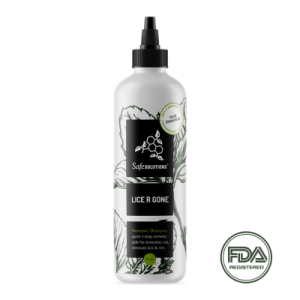 allows it to safely remove both lice & their nits, easily disrupting the entire lice lifecycle. Pesticide-free, pH balanced, biodegradable, will not damage color treated hair, non-toxic, and natural. An 8 oz. bottle contains at least 16 uses – enough for any follow-up cases that may pop-up.
allows it to safely remove both lice & their nits, easily disrupting the entire lice lifecycle. Pesticide-free, pH balanced, biodegradable, will not damage color treated hair, non-toxic, and natural. An 8 oz. bottle contains at least 16 uses – enough for any follow-up cases that may pop-up.
Directions: wet hair with warm water. Massage shampoo into the hair and scalp to form lather. Allow to stand for minimum 10-20 minutes (longer for stubborn “super-lice”), then rinse thoroughly.
How does Lice R Gone® work? The enzymes in the product exhibit the same properties as those that occur naturally in all insect species. Insects must undergo molting cycles in which they shed their exoskeleton to grow larger; they use enzymes to split open their shells. Because the biology of insects depends on the creation of enzymes in order for survival, it is impossible that insects will ever be able to develop a resistance to enzyme as a pest control device. Enzyme control relies on physical properties, rather than on toxic substances (chemical control) to achieve control over the insect.
Maintenance Control: Thoroughly vacuum each room where lice has been an issue daily. Spray or mop floors with TweetMint Enzyme Cleaner® or Not Nice To Bugs® using 1 oz (60 ml) per quart (liter). If dry-vacuuming add a pinch of food-grade diatomaceous earth to the vacuum to eliminate any captured lice. For school officials, assign each child a separate locker or hook for clothing items – do not allow intermingling of clothing articles.
For other safe controls:
- Salt Water: If living in close proximity to salt water, simply go for a swim. Otherwise, soak hair/body in salt water to control lice – but this method will not control their nits.
- Heat: cover hair with a shower cap and heat with a hair dryer, or visit a sauna.
Final Thoughts
Lice have been a pressing issue for as long as humans have been around – yet the synthetic chemicals used to treat them present much more danger than the lice themselves.
Take this article from the Jerusalem Post, one health official remarks that if Israel continues its path on using the conventional poisons, they will “never be ahead” of head lice populations. The vast majority of the available lice treatments do not work and lice populations are exploding after the COVID-19 lockdowns were repealed.
It is important to use a Pestisafe® that will not create resistance or poison you, your loved ones, or your patients. Trust Lice R Gone® as it is FDA-registered and has 20+ years of proven experience.
If you are a nurse, parent, school official, or health official wanting to learn more about lice treatments, reach out via gage@safesolutions.com or call 616.677.2850
For more information check out the Lice & Scabies Chapter at www.thebestcontrol2.com
For more sustainable alternatives continue browsing at www.safesolutions.com
– Gage

